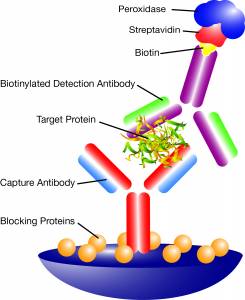

Immunoassay – An immunoassay is a biochemical test designed to measure the concentration or presence of a macro or micro molecule usually in a solution such as cell culture fluid, serum or plasma. The principle structure of an immunoassay is the typical sandwich ELISA.
ELISA – An ELISA assay or enzyme linked immunosorbent assay is usually a solid phase enzyme immunoassay where a capture antibody is attached to a solid surface such as wells of a 96 well polystyrene ELISA plate. The capture antibody is able to bind and capture the macro or micro molecule present in the tissue culture supernatant or serum that is added to the wells. Then a detection antibody conjugated to a reporter molecule such as horseradish peroxidase is added to the wells and it binds to an alternate epitope or binding domain on the captured molecule to be detected. This format is typically called a sandwich ELISA and is the most common of the ELISA formats. The antibody pair used in a sandwich ELISA are typically termed a matched pair because they each bind to a unique epitope or binding domain of the molecule to be detected without interference to each other enabling both antigen capture and detection.
Types of Reagents & Substrates
Buffers overall stabilize the antigen or antibody used to coat an ELISA microwell plate, optimizing absorption and interaction with the detection antibody. Substrates must be highly sensitive and are used to increase the rate of reaction (optimal density) in an assay and measured using a precision micro-titer absorbance plate reader, such as a spectrophotometer. Diluent additives are used in ELISAs to equalize any differences between the sample matrices (serum, plasma, urine, etc.) and the calibrator control used to generate a standard curve. Diluents are used when performing an assay to dilute samples and increase signal-to-noise ratios.
Enzyme Substrates – The enzyme substrate is used to detect the presence of the detection antibody conjugated to a reporter molecule such as horseradish peroxidase or alkaline phosphatase. A chromogenic substrate such as TMB or ABTS is a compound that after reacting with an enzyme, generates a colored product that is measured using a plate reader based on absorption of light or percent transmission of light at a specific wavelength. Chemiluminescence substrates convert chemical energy into the emission of visible light as a result of oxidation or hydrolysis. Two chemicals such as an enzyme and a substrate react to form an excited state intermediate which then breaks down releasing energy in the form of photons.
Coating Buffers – The correct ELISA plate coating buffer is a critical component of a plate based assay. The correct mixture of ions and pH help optimize the coating of an antibody to a polystyrene solid surface. In addition, special structural preservatives can be added to retain the antibody activity for long term storage after drying.
Blocking Buffers – Specially formulated blocking buffer solutions are commonly used in ELISA and other immunoassays to block excess binding sites and to reduce non-specific binding of detection antibodies or secondary antibodies. Depending on the sample origin and assay being developed, Leinco offers a range of blocking buffers containing mammalian proteins, full synthetic or fish proteins to maximize your assay’s signal to background ratio.
Wash Buffers – Washing buffers are pH balanced salt solutions usually containing a non-ionic detergent to effectively remove excess components that may alter assay signal. The wash buffer is used between certain reagent adding steps. Leinco offers several plate washing buffer options for you to consider during the assay optimization phase.
Our catalog contains all the products necessary for developing an immunoassay. However, if your requirements go beyond these products, our team of experts can further customize to meet your assays exact needs.
Assay Targets
Primary and Secondary Antibodies – The use of both a primary and secondary antibodies in assays allow for stronger visualization and localization of a dye to a specific antigen the assay is detecting the presence of. A primary capture antibody binds directly to the antigen, while the variable region of the primary antibody recognizes an epitope on that antigen. A secondary detection antibody then binds to the heavy chains of a primary antibody forming an antigen-antibody complex. Secondary antibodies are conjugated to a fluorophore or an enzyme, such as horseradish peroxidase (HRP) or alkaline phosphatase (ALP). The primary and secondary antibody differs in host species to minimize any false positives or unwanted background noise.
Matched Pair Antibodies – Matched pair antibodies are two antibodies, both a capture and detection antibody, each recognizing a different region or epitope of a target antigen. Leinco has identified and validated our matched antibody pairs in ELISA tests to accurately confirm ultrahigh specificity and binding.
Coated Microwell Binding Assay Plates – Microplate or microtiter plates (typically polystyrene) whose surfaces are coated with proteins or other biomolecules enable strong assay binding and detection of specific molecules found in test samples. Coated-plate assays use wash steps to separate any bound and unbound reagents from each well.

